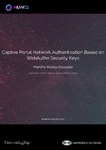Mostrar o rexistro simple do ítem
Captive Portal Network Authentication Based on WebAuthn Security Keys
| dc.contributor.advisor | Vázquez-Naya, José | |
| dc.contributor.advisor | Gestal, M. | |
| dc.contributor.author | Rivera-Dourado, Martiño | |
| dc.contributor.other | Universidade da Coruña. Facultade de Informática | es_ES |
| dc.date.accessioned | 2022-10-31T14:36:03Z | |
| dc.date.available | 2022-10-31T14:36:03Z | |
| dc.date.issued | 2022 | |
| dc.identifier.uri | http://hdl.handle.net/2183/31921 | |
| dc.description.abstract | [Abstract]: Network authentication is performed via different technologies, which have evolved together with authentication systems in other environments. In all these environments, the authentication paradigm during the last decades has been the well known password. However, passwords have some important security problems, like phishing or keylogging. In 2019, the WebAuthn standard from the W3C started a new authentication paradigm based on hardware devices known as security keys. Although they are already being used in many web authentication services, they have not yet been integrated with network authentication mechanisms. This work successfully developed and integrated an authentication server based on WebAuthn security keys with a captive portal system. With this solution, users can be authenticated using security keys within a web-based captive portal network authentication system that gives clients access to network resources. The resulting authentication server is compatible with major operating systems like Windows 10 and Ubuntu 20.04, browsers like Firefox and Google Chrome and security keys like the Solokey and the Yubikey. | es_ES |
| dc.description.abstract | [Resumo]: A autenticación de rede realízase a través de diferentes tecnoloxías, que evolucionaron xunto con sistemas de autenticación noutros escenarios. En todos estes escenarios, o paradigma de autenticación durante as últimas décadas foi o coñecido contrasinal. Porén, os contrasinais teñen algúns problemas de seguridade importantes, como o phishing ou o keylogging. En 2019, o estándar WebAuthn da W3C comezou un novo paradigma da autenticación baseado en dispositivos físicos coñecidos como chaves de seguridade. Aínda que estas xa se están usando en moitos servizos de autenticación web, aínda non foron integradas en mecanismos de autenticación de rede. Este traballo desenvolveu e integrou con éxito un servidor de autenticación baseado en chaves de seguridade WebAuthn cun sistema de portal cativo. Con esta solución, os usuarios poden autenticarse usando chaves de seguridade nun sistema de autenticación de rede con portal cativo baseado en web que da acceso aos clientes a recursos de rede. O servidor de autenticación resultante é compatible con sistemas operativos relevantes como Windows 10 ou Ubuntu 20.04, navegadores como Firefox e Google Chrome e chaves de seguridade como a Solokey e a Yubikey. | es_ES |
| dc.language.iso | eng | es_ES |
| dc.rights | Atribución-NoComercial-SinDerivadas 3.0 España | es_ES |
| dc.rights.uri | http://creativecommons.org/licenses/by-nc-nd/3.0/es/ | * |
| dc.subject | Network authentication | es_ES |
| dc.subject | Captive portal | es_ES |
| dc.subject | WebAuthn | es_ES |
| dc.subject | FIDO | es_ES |
| dc.subject | Passwordless authentication | es_ES |
| dc.subject | Autenticación de rede | es_ES |
| dc.subject | Portal cativo | es_ES |
| dc.subject | Autenticación sen contrasinais | es_ES |
| dc.title | Captive Portal Network Authentication Based on WebAuthn Security Keys | es_ES |
| dc.type | info:eu-repo/semantics/masterThesis | es_ES |
| dc.rights.access | info:eu-repo/semantics/openAccess | es_ES |
| dc.description.traballos | Traballo fin de mestrado (UDC.FIC). Ciberseguridade. Curso 2021/2022 | es_ES |






